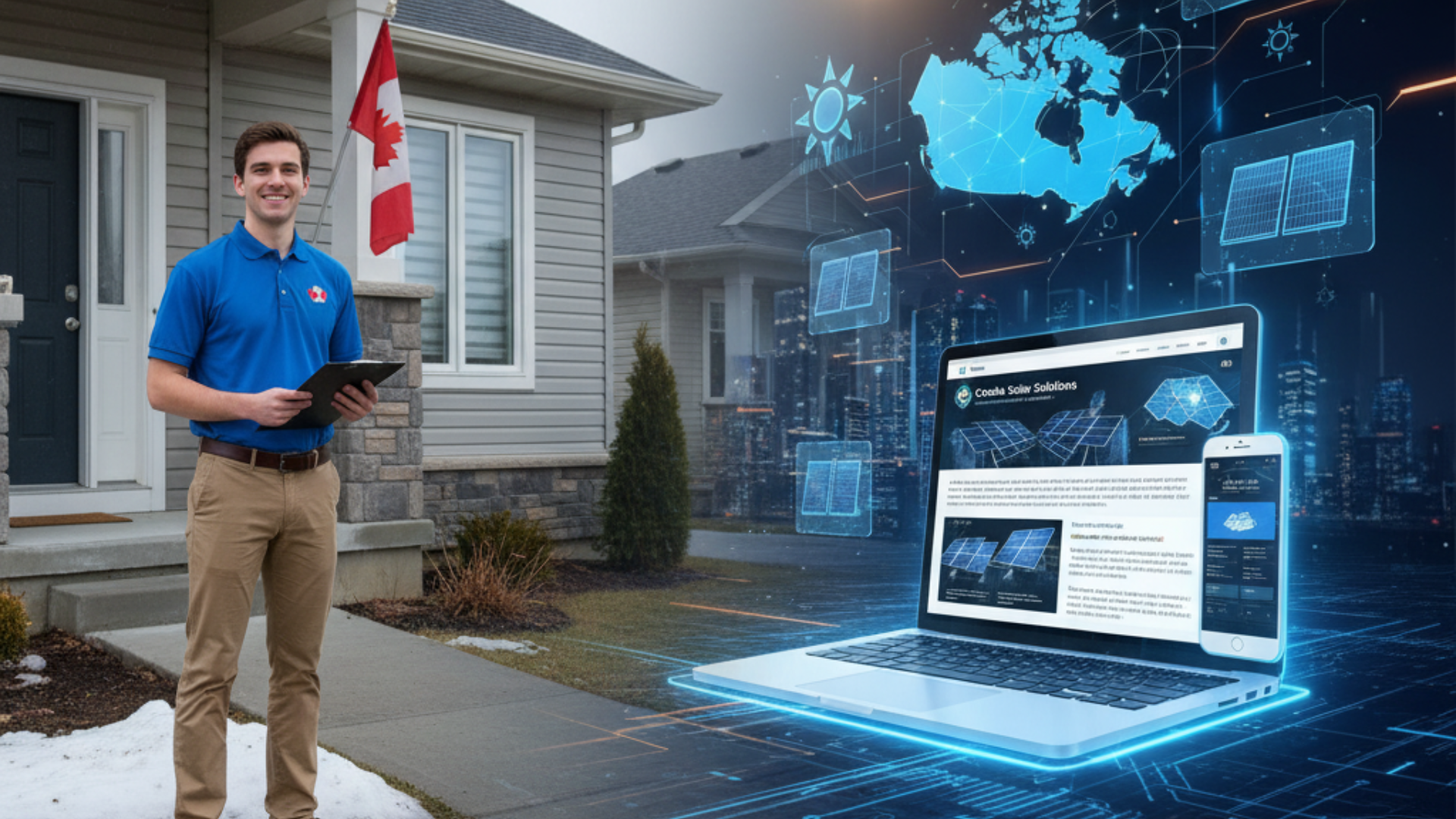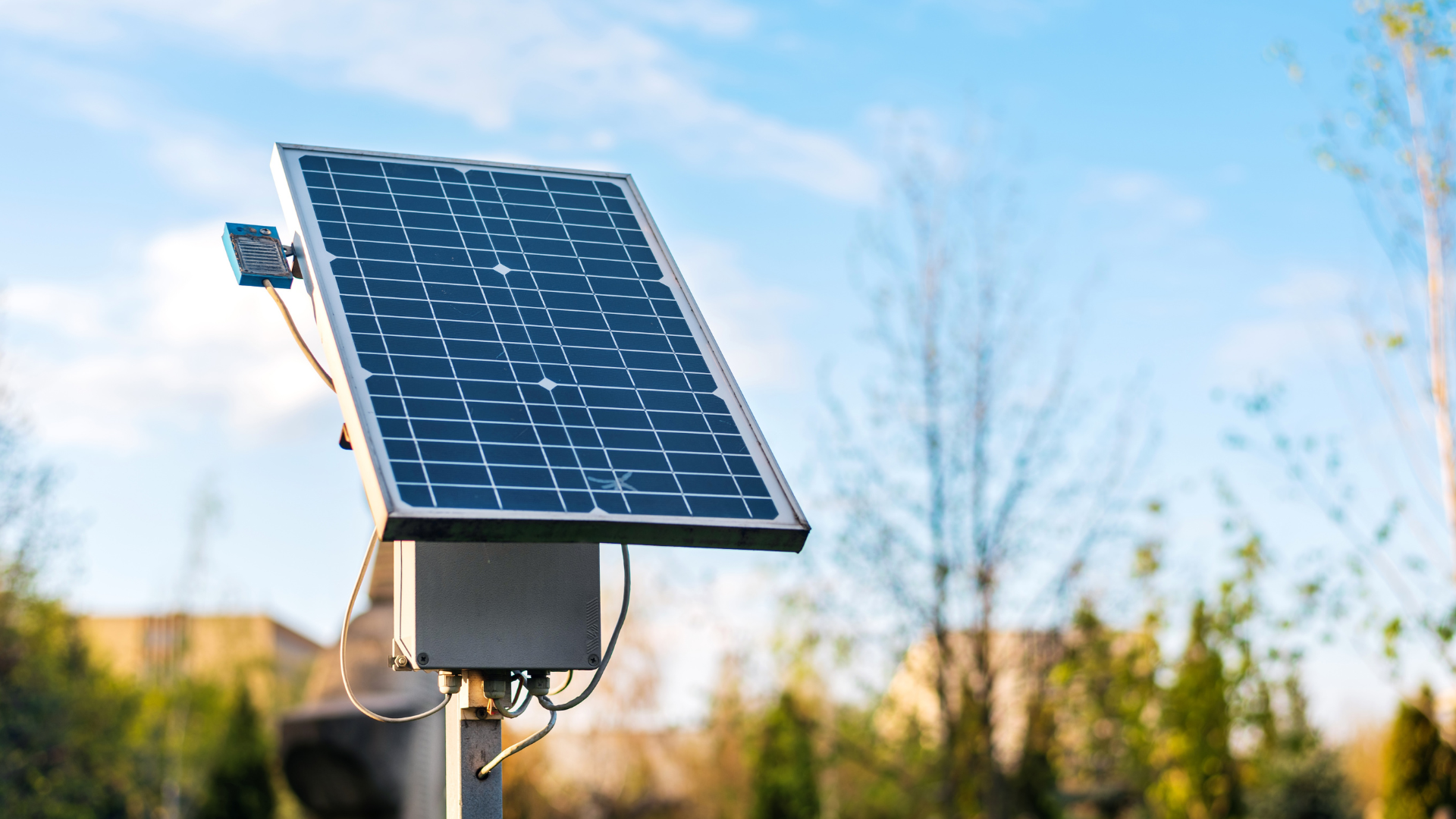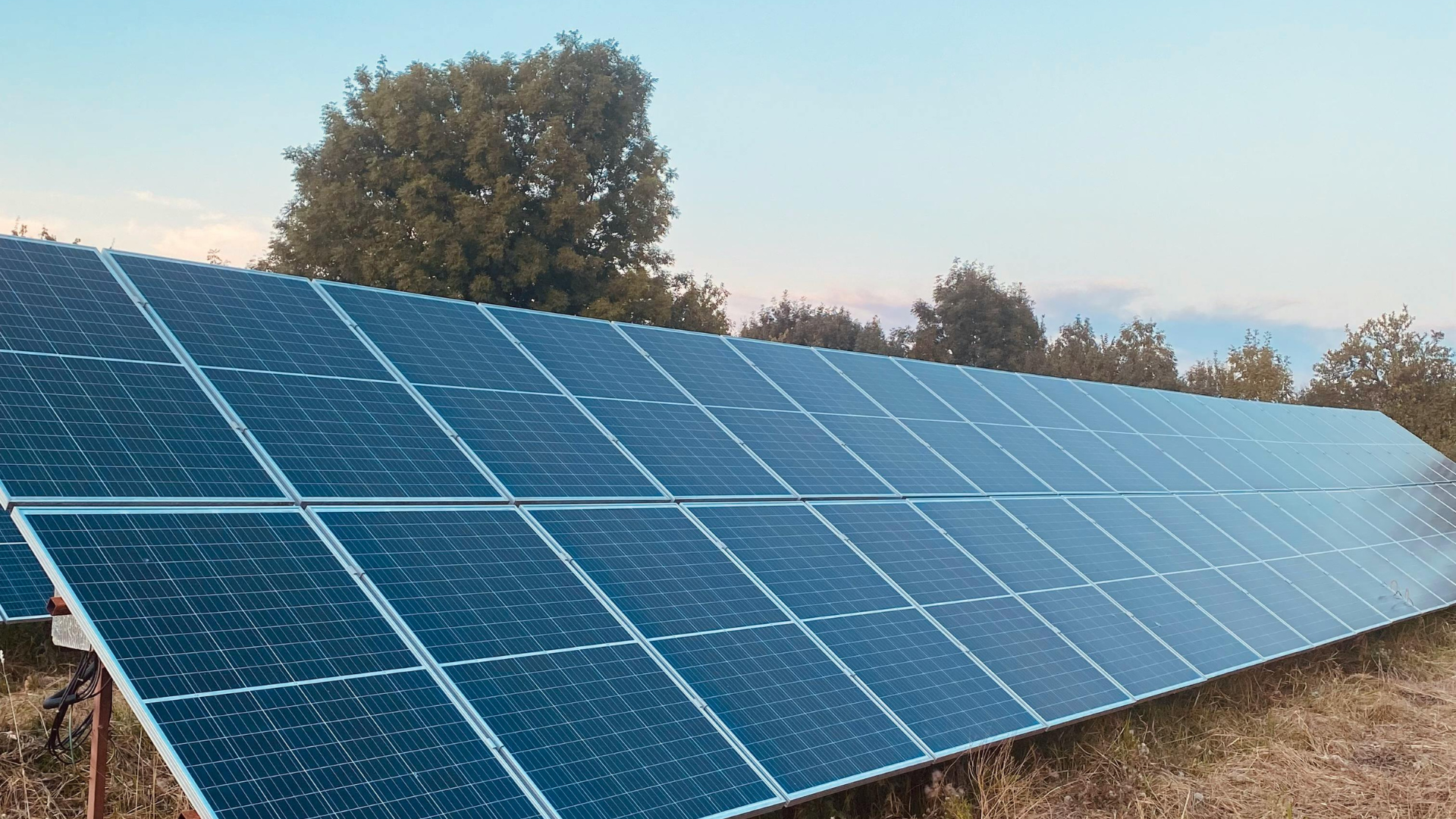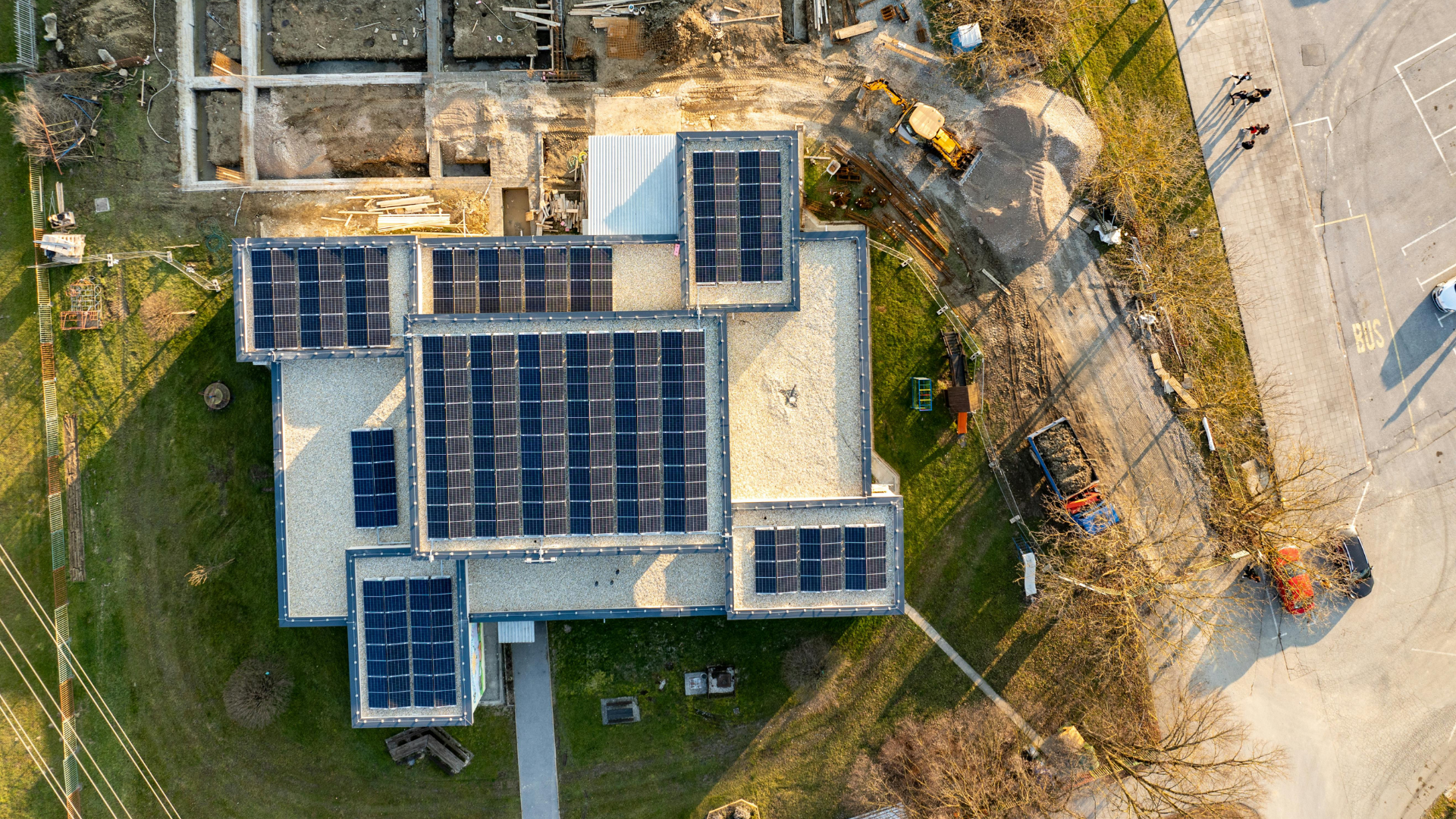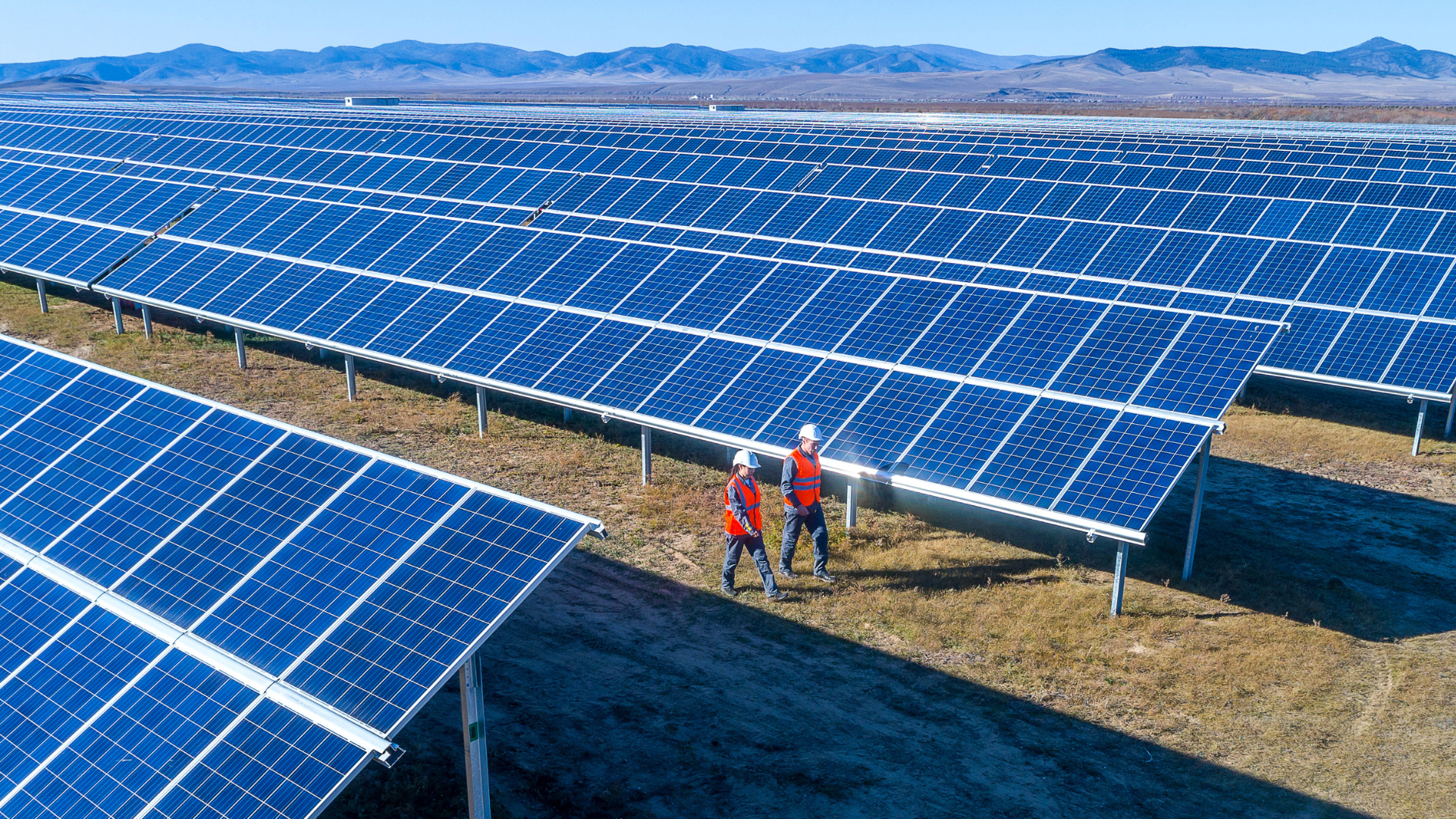November 13, 2025
Audio overview: Listen & Learn
As a solar consultant, you might already have hired more solar sales reps, spent on ads, built a new landing page, and even offered free visits to get interest. Then why are you waking up to an empty calendar?
Many companies in the solar industry face the same challenges, and it's not because your product lacks value. It could be the best product in the world, but if your potential customers never see it, then it stays hidden.
This guide offers you a full-funnel sales system that's repeatable and consistently delivers results. We have cut through the noise of recycled tips and generic advice by breaking down what actually works in solar sales today.
Full-Funnel Solar Sales Blueprint for Modern Solar Companies
To stand out from the crowd of blogs on solar sales and the million promises to sell more products, we have provided the structure that works. Let's get into the complete blueprint you need to generate better leads, qualify faster, and close more deals.
Key Takeaways
- A strong solar sales strategy is built on clarity, consistency, and automation—all of which help teams convert more leads with less effort.
- Most solar companies lose deals due to a lack of structure and follow-up automation.
- A clean, data-driven sales funnel ensures predictability and higher close rates.
- Data-driven decisions based on metrics such as conversion rates and cost per lead ensure smarter growth and better ROI.
- CRM and proposal tools simplify qualification, tracking, and relationship-building.
- Success = Consistent lead generation + clear qualification + fast proposals + confident closing.
Understanding the Solar Sales Funnel
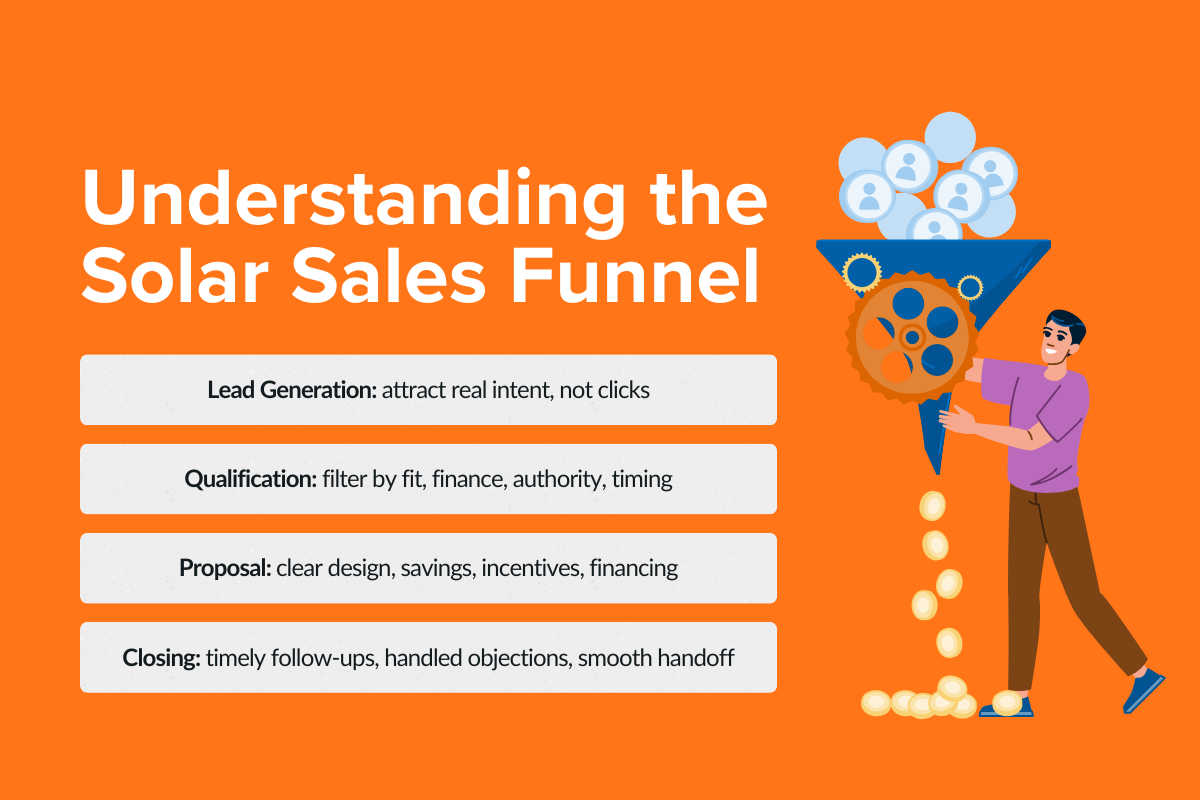
Every customer journey in the renewable energy sector follows four connected stages that, when aligned, turn interest into predictable revenue.
1. Lead Generation
Your potential solar customers are already online, searching for solar energy products. This is where their attention becomes your opportunity.
Whether you’re reaching homeowners through digital campaigns, door-to-door canvassing, or referrals, the goal is to attract people who are genuinely curious about solar, not just browsing for information.
2. Qualification
Not every lead is worth chasing, and the qualification stage helps you focus your time and energy on prospects who actually have the interest, authority, and financial ability to move forward. A good CRM can automatically flag those indicators, saving hours of guesswork.
3. Proposal
Once a lead is qualified, the proposal stage is where value and clarity meet. This is where design tools, production estimates, the benefits, and financing options come together to paint a clear picture of savings and reliability. A well-structured proposal builds trust faster than any sales pitch.
4. Closing
Closing is less about pressure and more about timing. When your funnel is organized, every follow-up happens at the right moment, and every objection gets handled with confidence, and that gives a smoother handoff from intent to signed contract.
Why a Structured Solar Sales Process Is Non-Negotiable
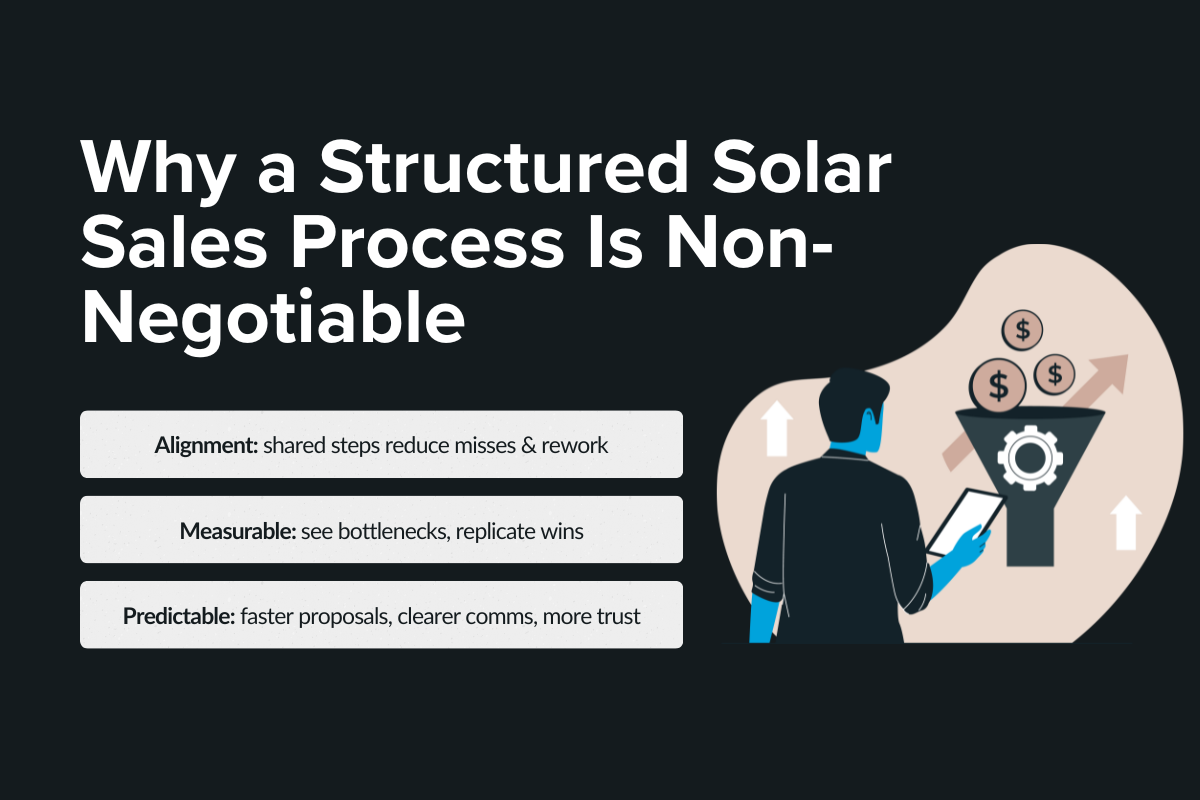
A busy pipeline doesn’t guarantee results. You might be generating tens of thousands of leads and sending proposals regularly, but if your sales process lacks structure, those efforts rarely translate into consistent closes.
1. Structure Brings Alignment
A defined sales process ensures everyone, from marketers to consultants to installers, follows the same steps from the first contact to the signed contract.
When each stage has a clear purpose and next action, you eliminate confusion, missed follow-ups, and conflicting handoffs. This, in turn, helps the entire team move with direction and accountability.
2. It Makes Performance Measurable
Without structure, it’s impossible to tell what’s working and what’s not. A documented process shows exactly where deals slow down, which reps convert best, and where leads drop off.
With that visibility, managers can fix bottlenecks, replicate success, and make data-driven improvements instead of relying on instinct.
3. It Builds Predictability and Trust
Solar sales will always rely on people and relationships, but a structured process makes outcomes repeatable.
When customers experience smoother communication, faster proposal turnaround, and greater transparency, it strengthens trust and improves close rates.
4 Stages Of The Solar Sales Funnel
A well-structured sales funnel helps solar companies identify where each prospect stands and tailor their approach accordingly.
Here’s a breakdown of the four key stages that turn a curious lead into a confident solar customer:
Stage 1: Solar Lead Generation — Building a Predictable Pipeline
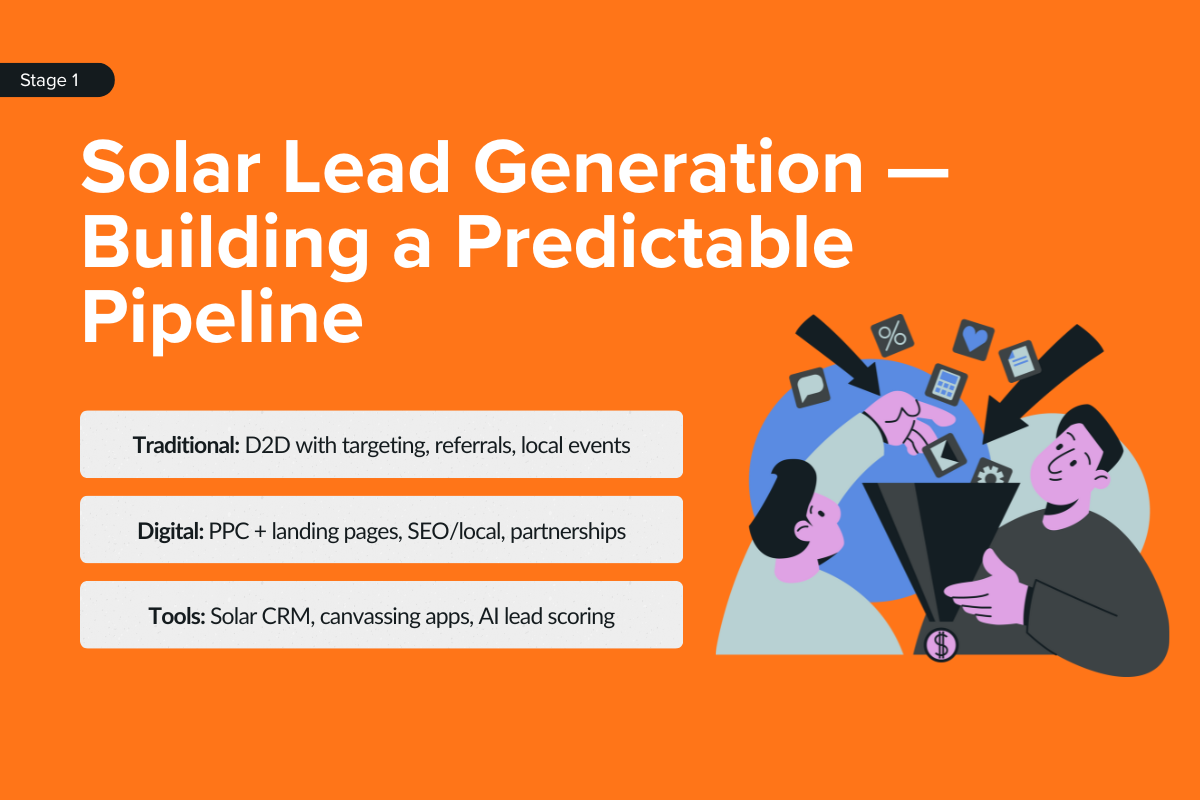
In solar sales, a strong sales funnel is more important than lead volume. A homeowner ready to switch to solar is very different from someone just browsing ads for cost estimates.
That’s why top-performing sales representatives mix traditional outreach with modern digital tools to create a balanced, predictable pipeline.
A. Traditional Channels That Still Work
Despite the digital shift, traditional channels continue to drive high-intent conversations when executed well.
- Door-to-door canvassing: It is one of the most powerful lead sources because it’s immediate and personal. The key is precision, using neighborhood data, solar potential maps, and canvassing apps to target homes that already meet the right criteria.
- Referrals: A happy customer is your best salesperson, and that's why building a simple referral system, such as offering maintenance discounts or gift cards for every successful referral, keeps your existing customers engaged while generating warm, pre-qualified leads.
- Community-based lead generation: Local events, sustainability fairs, and home expos give you face-to-face time with homeowners who already care about energy independence. Showing up with real examples of savings and installation photos builds trust faster than any ad campaign can.
B. Digital Channels for Scale and Visibility
Digital lead generation meets modern consumers where they already are: online platforms.
- Paid ads on Meta, Google, and YouTube: This method remains reliable for awareness and lead capture, especially when combined with strong landing pages and real-time follow-up. Instead of generic “Go Solar Now” messaging, focus on local proof like energy bills saved in a specific area or customer testimonials from nearby installations.
- SEO and local search optimization: Most homeowners type queries like “solar installer near me” or “best solar panels for my roof.” Ranking for these terms means your business appears exactly when intent peaks. You can own that visibility by creating educational blog posts, location pages, and optimizing your Google Business Profile.
- Partnerships: Collaborating with roofing, HVAC, or real-estate companies puts your brand in front of qualified homeowners who already trust those services, thus amplifying your reach. Even if those leads start small, they often convert faster because trust is already built.
- Lead marketplaces: Using a lead marketplace can quickly fill your CRM, but they’re not always the best long-term strategy. Many sell shared or recycled leads, leading to lower conversion rates and higher competition. They can be a short-term boost, but your real focus should be building your own, organic lead pipeline.
C. Tools That Help You Stay Organized
As a solar sales consultant, you know this field moves fast, and that's why having the proper tools and a system saves good leads from slipping away.
- Solar CRM: It keeps your entire pipeline organized, from capturing web form submissions and canvassing data to tracking every follow-up. When integrated with proposal software, it becomes a full visibility dashboard, and you get to know who’s new, who’s ready, and who’s gone quiet.
- Geo-targeted canvassing apps: It makes field sales smarter by helping your reps plan routes efficiently, drop pins for interested homeowners, and sync notes back into the CRM instantly.
- AI-based lead-scoring systems: This removes the guesswork from prioritization and makes it easier to analyze engagement patterns, like response time, form depth, and location fit, to tell your team which prospects deserve a call today and which should stay in nurture campaigns.
When traditional and digital channels work together, supported by the right tools, your team stops chasing
leads and starts managing opportunities.
Also read: How Solar CRM Transforms Lead Management
Stage 2: Qualifying Solar Leads: Filtering for Real Buyers

Once leads start flowing in, the next challenge is knowing which ones are actually worth your team’s time. Every homeowner who clicks an ad or fills out a form shows curiosity, but curiosity isn’t commitment.
Qualification is about separating intent from interest by identifying who’s truly ready to buy and who still needs nurturing.
A structured qualification process helps your sales representatives focus their energy where it counts. It shortens your sales cycle, improves proposal accuracy, and ensures your follow-ups feel relevant instead of repetitive.
A. Understanding What Makes a Qualified Solar Lead
In solar, qualification goes beyond demographics. A qualified lead meets three core criteria:
- Technical Fit: Does the property have a suitable roof size, orientation, and sunlight exposure?
- Financial Fit: Can the homeowner access financing, tax credits, or incentives?
- Intent & Authority: Are they the decision-maker, and are they considering installation within a realistic timeline?
By defining these parameters early, you reduce wasted effort chasing renters, low-credit leads, or properties that can’t host panels.
B. Gathering the Right Data Early
The best qualification happens before the first sales call. As a solar sales specialist, you can use your lead-capture forms and CRM to automatically gather key details, such as roof ownership, monthly electricity spend, and location.
Tip: Integrating design tools or APIs that pre-screen rooftops based on orientation or shading can help filter out poor-fit leads instantly.
For example, a form that asks for “average monthly electricity bill” might seem simple, but it’s one of the fastest ways to identify who actually benefits from solar. A homeowner spending $150–$200 or more per month on electricity will typically see a quicker ROI and be far more motivated to invest in solar than someone paying only $60–$80.
C. Lead Scoring: Prioritize Who Deserves a Call
Lead scoring gives structure to intuition. By assigning points to certain behaviors or traits, such as clicking a pricing page (+5), scheduling a site visit (+10), or ignoring follow-ups (-5), your CRM can automatically rank prospects by readiness.
D. The Payoff of Solid Qualification
Strong qualification means fewer proposals that go nowhere and more contracts that actually close. It also keeps your pipeline clean, so your team can see exactly who’s moving forward, who’s on hold, and who needs follow-up next week.
When done right, qualification transforms your entire funnel from reactive to predictable. It’s the difference between chasing every lead and confidently guiding the right ones to the next stage.
Stage 3: Crafting Solar Proposals & Financing Options That Close Deals
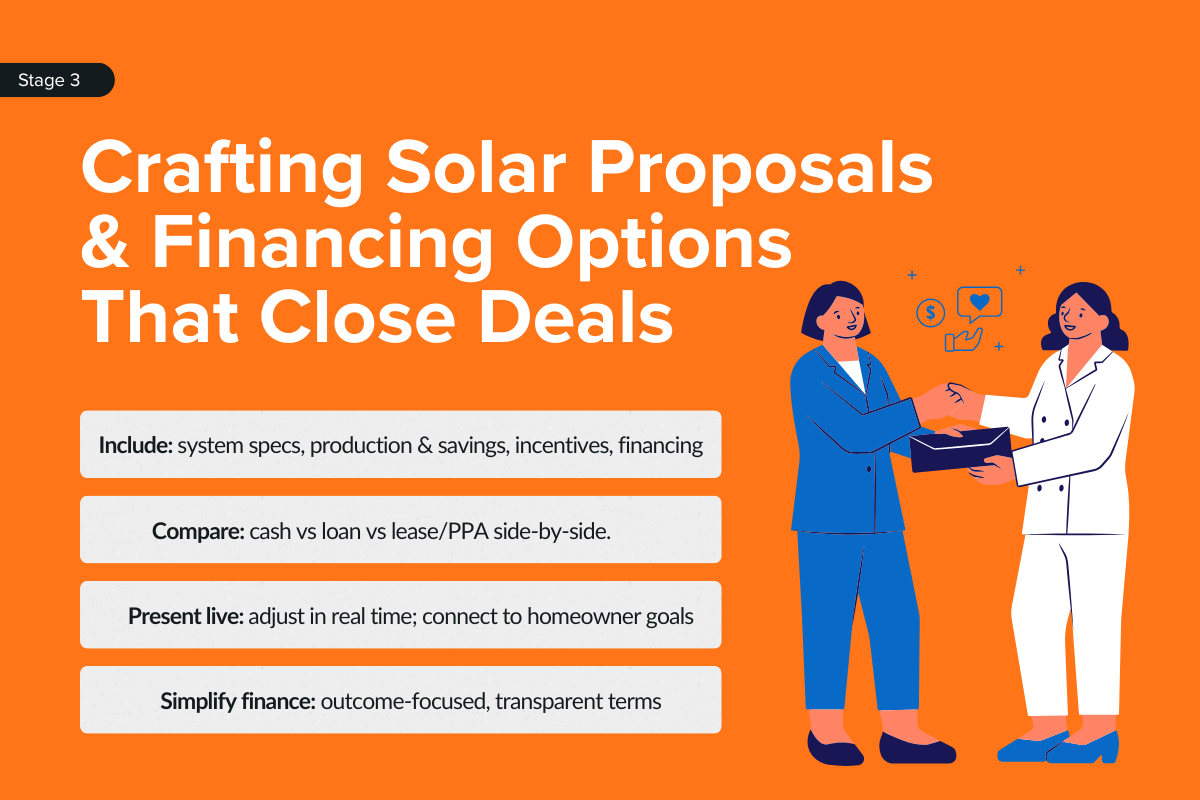
Once a prospect is qualified, the next step is to turn their interest into conviction. The proposal stage is where your technical knowledge, credibility, and timing come together to create trust.
A strong proposal does two things: it clarifies what the customer is buying, and it simplifies their decision.
When a homeowner can see their savings, understand their financing, and visualize the installation outcome, hesitation disappears.
A. What Every Winning Solar Proposal Should Include
Your solar proposal should serve as a communication tool, conveying what, why, and how much in one place.
1. System design and specs: Explain the configuration clearly: panel type, inverter choice, capacity (kW), and expected lifespan. Use visuals, show the roof layout or production map so homeowners can picture their setup.
2. Energy production & savings forecast: Break down the monthly and yearly generation estimates based on their consumption data to build confidence. Include comparisons: “Your current bill ≈ $220/month → projected ≈ $60/month.”
3. Incentives & tax credits: List all available federal and state incentives. For U.S. homeowners, this means highlighting the Federal Solar Tax Credit (ITC) and any state-specific rebates. Add links or references so customers can easily verify.
4. Financing options: Not every homeowner can or wants to pay up front. Offer clear, side-by-side comparisons of purchase, loan, and lease models so they can choose based on comfort, not confusion. Guide them by keeping the tone neutral instead of pushing.
| Model | Ownership | Upfront Cost | Monthly Payment | Typical ROI |
|---|---|---|---|---|
| Purchase (Cash) | You own the system | Highest | None | 5–7 years |
| Loan (Solar Financing) | You own the system | Low/None | Fixed monthly | 7–10 years |
| Lease/PPA | The installer owns it | None | Pay per kWh | Savings start Day 1 |
5. Timeline & next steps: End with a clear roadmap: site visit → permit → installation → activation. Prospects should leave the meeting knowing exactly what happens after they sign.
B. How to Present Your Solar Proposal
A polished, interactive proposal feels different from a PDF attachment. Platforms like Sunbase let you generate dynamic proposals directly from your CRM data, adjusting system size, pricing, and incentives in real time during a call or meeting.
When you present, start with the homeowner’s goals: lower bills, energy independence, and sustainability. Then connect those goals back to the numbers in the proposal.
If you frame it as “Here’s how we help you reach that goal,” rather than “Here’s what you’ll pay,” the conversation stays positive and consultative.
Also read: Solar Design Software Comparison: Features & Pricing.
C. Explaining Financing Without Overwhelming the Prospect
Financing is often where deals stall, not because the options are bad, but because the explanation feels complex.
You can simplify it by focusing on outcomes:
- Cash purchase: highest long-term savings, quickest payback.
- Loan: minimal upfront cost, monthly payment roughly equal to the current utility bill.
- Lease/PPA: no ownership responsibility, immediate monthly savings.
Be transparent about credit requirements, transfer rules, and interest rates.
Stage 4: Closing Solar Sales — Building Relationships That Drive Conversions
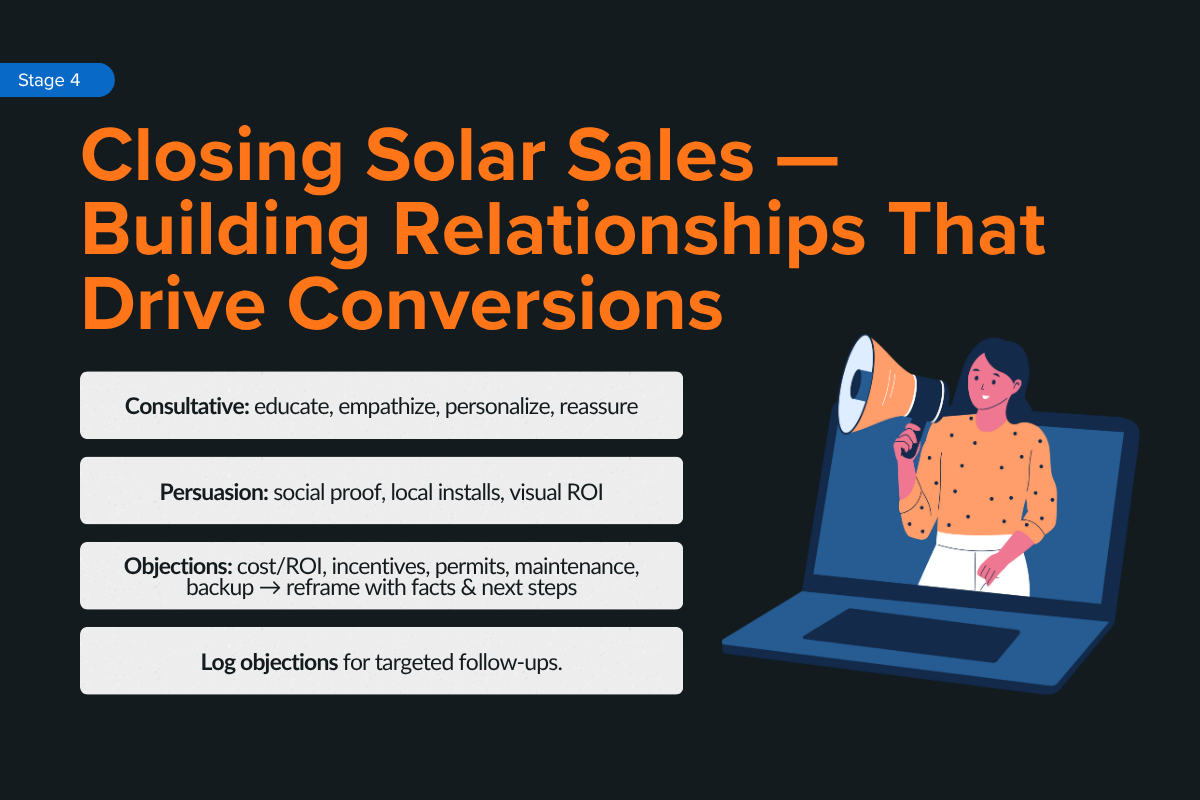
Solar sales aren’t purely transactional. They’re emotional, financial, and long-term, as homeowners are investing in a system that sits on their roof for 25 years, they need to believe in both the product and the people installing it.
A. Trust-Based Consultative Selling
As a door-to-door sales rep, your goal should be to help potential customers make a confident, informed decision, acting more like an advisor than a closer.
Ask questions that reveal what matters most to them:
- “What’s motivating you to explore solar right now?”
- “Do you want to lower bills, become energy independent, or both?”
These conversations show empathy and surface the emotional drivers behind a purchase. When you slow down to listen, customers speed up to commit.
B. Behavioral Persuasion Techniques
Small psychological cues can strengthen trust and encourage action without manipulation.
- Social Proof: Showcase installations in the same neighborhood. When prospects know “five homes on your street already switched,” credibility skyrockets.
- Visual ROI: Replace abstract savings with tangible visuals like monthly bill comparisons, graphs showing year-over-year savings, or photos of a similar home’s install.
- Neighborhood Adoption: Referring to local trends like “Solar installations in your zip code have increased 38% this year,” can help potential customers in deciding to select solar energy products
C. Relationship-Building Framework For the Solar Industry
Every interaction should follow four natural steps: Educate → Empathize → Personalize → Reassure
- Educate: Provide customers with clear benefits, incentives, and the process in plain English, avoiding jargon.
- Empathize: Acknowledge their concerns from installation mess to financing stress.
- Personalize: Tie the solution back to their specific usage, roof, and goals.
- Reassure: Summarize next steps and remind them that your team handles everything, permits, paperwork, and support.
This framework turns what could feel like a sales pitch into a guided partnership.
D. How Solar Sales Representatives Can Humanize Every Interaction
While technology improves efficiency, you need to build trust by keeping proposals conversational and following up with context.
- Storytelling: Share a short customer success story, “The Smiths down the street cut their bill by 60% in the first month.”
- Empathy in Tone: Avoid robotic follow-ups like “Just checking in.” Try “I remember you were comparing financing options. Want me to walk you through updated rates?”
- Personalized Proposals: Use CRM data to include small details such as the exact roof type, local rebates, or their city’s energy costs. These reminders show care and preparation.
While selling solar systems, the technology and pricing often look similar, making your sales skills and how you communicate the real differentiator.
Solar companies that sell with empathy, transparency, and personalization create advocates who keep the pipeline full through referrals and trust.
Check out: Solar Sales Playbook: Scripts and Tactics for Field Teams
E: Objection Handling for Solar Sales Consultant
Even with a solid proposal and great rapport, potential buyers will still have questions, and that’s a good thing. Objections are a sign they’re engaged and evaluating seriously. Now, your goal becomes not to argue, but to clarify, reassure, and refocus.
A confident solar sales representative anticipates these moments and handles them with calm authority, not scripts.
Common Solar Objections and How to Reframe Them
| Objection | What It Really Means | Example Response |
|---|---|---|
| “Solar is expensive.” | They’re unsure about ROI or upfront costs. | “That’s a fair concern, as we discussed earlier, most homeowners see full payback within 4–6 years, and from there, it’s decades of free power. Financing makes it easier to start without the large upfront cost.” |
| “I’m not sure the incentives will last.” | They’ve heard conflicting information. | "Good question, the 30% Federal Investment Tax Credit (ITC) is secured through 2032, and state-level rebates can still be claimed. Our team handles all paperwork so you don’t miss any benefits.” |
| “Permits and paperwork sound complicated.” | They’re worried about red tape. | "Totally understandable, that’s exactly why we manage the entire permitting and interconnection process in-house. You’ll just get progress updates.” |
| “What about maintenance?” | They assume panels need constant care. | “Panels are low-maintenance and usually just require occasional cleaning. And if anything changes in performance, our monitoring system alerts us before you even notice.” |
| “What if the grid fails?” | They don’t understand grid-tied vs. backup. | “Great point, we can pair your system with a battery backup, so you’ll stay powered even during outages.” |
Turning Objections Into Follow-Up Opportunities
Instead of letting an objection end the conversation, log it in your CRM as a signal for tailored follow-up.
For instance, if a lead shows hesitation about ROI, trigger an automated email with a short case study or savings calculator. If they’re concerned about maintenance, send an explainer video on durability and warranty.
By tagging and responding through automation, you create a system that learns from resistance, converting “not yet” into “ready next month.”
Beyond the Close: Turning Existing Customers into Growth Engines
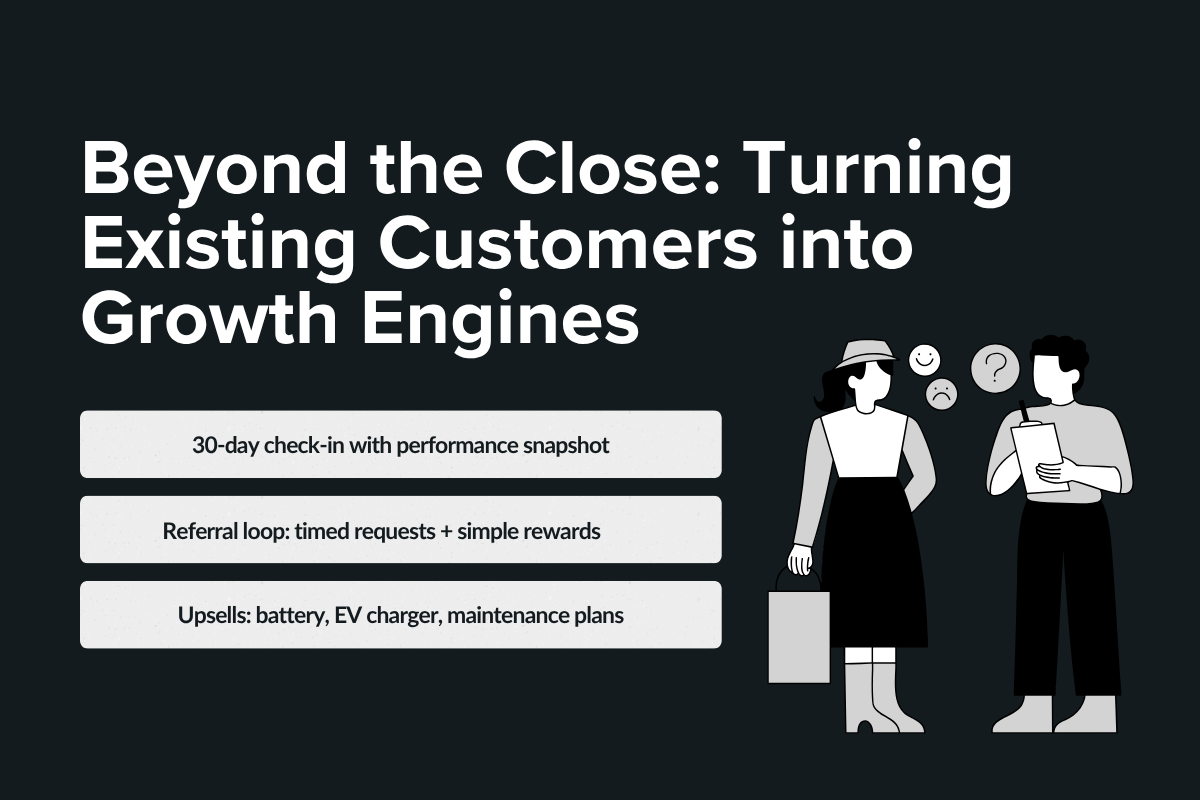
Closing a sale isn’t the end of the funnel; it’s the start of a relationship that can drive your next ten.
In solar, where trust spreads through neighborhoods and communities, every satisfied customer becomes a potential brand ambassador.
A. Post-Sale Nurturing: Staying Present After Installation
Once the panels are live, many sales reps move on, but the customer’s experience is just beginning.
A short check-in within the first 30 days can make a massive difference:
- Ask if everything’s working as expected.
- Share a quick performance snapshot (“You’ve generated 600 kWh in your first month, that’s $85 saved!”).
- Offer support if they have questions about billing or monitoring.
The goal is to stay visible enough that when a neighbor asks, “Who did your solar?”, your customer answers instantly.
B. Referral Loops: The Easiest Way to Generate Qualified Leads
Referrals convert faster and cheaper than any paid campaign because trust is already built.
Instead of waiting for word of mouth, make referrals part of your process:
- Offer simple rewards (e.g., $250 credit or maintenance discount for each closed referral).
- Automate reminders in your CRM: send referral requests 60 days after installation, when satisfaction is highest.
- Add easy-share links or QR codes to post-installation emails so customers can refer friends with a single click.
A clean referral program turns goodwill into a predictable pipeline, keeping your CAC (customer acquisition cost) low.
C. Upselling and Cross-Selling Opportunities
The post-sale stage is also prime time for upgrades. Once trust is established, customers are far more open to adding products that deepen value.
Common solar upsells include:
- Battery storage systems for backup power.
- EV charging stations for electric vehicles.
- Maintenance plans or extended warranties.
Tracking, Optimization & Scaling Your Solar Sales Process

Tracking performance helps you understand what’s working, what’s slowing down, and where to double down.
Optimizing the process turns that data into action, and when every stage becomes predictable, scaling your sales operation becomes far less risky.
A. Core KPIs to Monitor
| KPI | Description | Why It Matters |
|---|---|---|
| Lead-to-Qualification Rate | Percentage of total leads that meet your qualification criteria. | Shows if your marketing is attracting the right audience. |
| Proposal Acceptance Rate | How many qualified leads move forward after receiving a proposal? | Reflects clarity, pricing accuracy, and communication quality. |
| Lead Response Time | Average time between lead capture and first contact. | Leads contacted within an hour are 7x more likely to convert. |
| Sales Cycle Length | Time from initial contact to signed contract. | Shorter cycles indicate stronger qualification and follow-up automation. |
| Close Rate (Lead-to-Customer) | Ratio of total leads closed versus total generated. | Measures overall funnel effectiveness and rep performance. |
| Referral Rate | Percentage of new business from existing customers. | Indicates satisfaction, trust, and post-sale relationship strength. |
| Cost per Acquisition (CPA) | Total marketing + sales cost per new customer. | Ensures your scaling efforts remain efficient and profitable. |
B. Continuous Improvement Framework
Once you’re tracking the right metrics, the next step is to use them to improve your process continuously.
- Measure: Review weekly data across each funnel stage (lead generation, qualification, proposal, and closing).
- Identify: Pinpoint bottlenecks: are proposals getting stuck, or are leads dropping after the first contact?
- Adjust: Update playbooks, scripts, or automations based on the numbers.
- Automate: Use your CRM to set rules that prevent repeat errors, for example, “If no follow-up in 24 hours, send a reminder.”
- Review & Repeat: Make continuous optimization a culture, not a quarterly project.
How to Manage Sales Teams for Consistent Conversions

1. Use Dashboards for Clarity: Dashboards help your team see exactly what’s happening in real time. Instead of relying on manual updates or gut instinct, clear performance tracking keeps everyone aligned and accountable.
2. Train New Reps on Tools and Process: Every new hire should understand your sales process. Practical, hands-on training helps them learn faster than long presentations. The goal is for every rep to use the same tools in the same way, so nothing gets missed.
3. Keep Motivation High: Set simple goals and recognize consistent effort, not just big wins. Whether it’s tracking quick follow-ups or clean pipelines, rewards and recognition help maintain momentum. A culture that celebrates progress encourages reps to keep improving instead of burning out.
4. Bridge Field and Inside Sales Teams: When canvassing and inside sales teams communicate often, leads move faster through the funnel. Field reps should pass details quickly, and inside reps should follow up within hours, not days. Shared systems and open communication prevent overlap and help both teams close more deals.
5. Real-World Example: Cutting Response Time: One solar company using Sunbase improved its close rate by cutting lead response time by 60%. The shift was to set clear response goals, track them daily, and reward reps who reached out the fastest. Faster responses built trust and naturally boosted conversions.
How Sunbase Powers a Winning Solar Sales Process
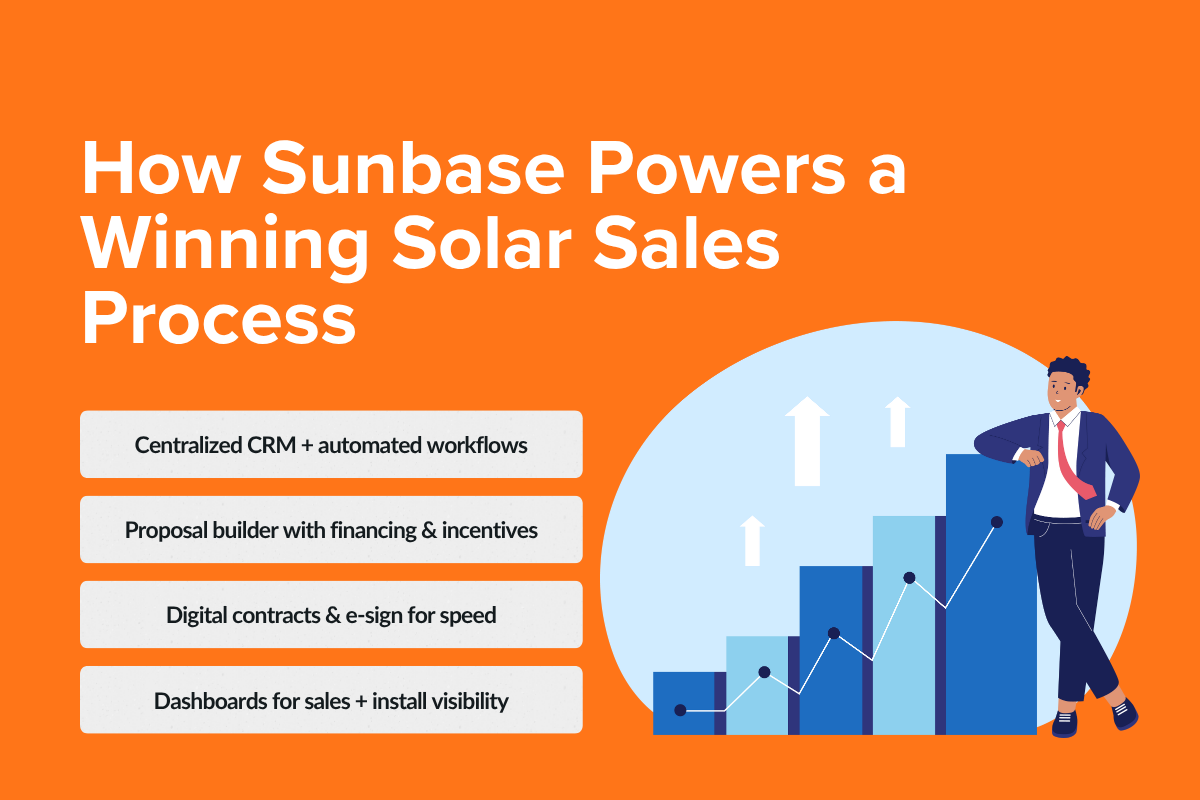
A strong solar sales system runs on clarity, consistency, and automation, and Sunbase brings all three together. It’s built to help solar companies manage their entire sales cycle from one connected platform.
- Centralized CRM & Automated Workflows: Capture leads from multiple sources, track every interaction, and set automatic follow-ups and task reminders. With a clear view of your pipeline and automated next steps, your reps never miss a lead or repeat effort.
- Proposal Builder with Built-In Financing & Incentives: Create branded, accurate proposals in minutes while showcasing side-by-side financing options and incentive eligibility. Customers see both the numbers and the savings clearly, helping them make confident decisions faster.
- Digital Paperwork & E-Signatures: Eliminate delays with digital contracts that customers can sign from any device. It shortens turnaround time and makes handoffs to operations smooth and traceable.
- Dashboards, Reporting & Project Tracking: Monitor performance metrics, team activity, and installation progress from a single dashboard. Real-time data helps you make quick adjustments and keep your process transparent from sale to installation.
- Solar Design & System Accuracy:
Design high-precision solar systems with tools that calculate energy production, shading impact, and financial performance. Sunbase integrates design insights directly into proposals, so customers understand both the layout and expected ROI.
With everything from CRM to proposals to project tracking under one roof, you can scale faster, close smarter, and deliver better customer experiences.
Conclusion
The solar market is more competitive than ever, and the difference between growing and stalling often comes down to how structured your sales process is. From lead generation to closing success depends on how well your team connects data, tools, and people.
By refining every stage of the funnel, tracking what works, and creating a repeatable system, solar businesses can move beyond guesswork and start scaling with confidence.
Your Complete Solar Sales Blueprint Starts Here
Sunbase unites your CRM, proposals, financing, and operations into one connected system, giving your team full visibility from lead to installation. With a cleaner pipeline and fewer moving parts, your reps spend less time managing tools and more time closing deals that last.
Ready to streamline your solar sales process and scale faster? Book a demo with Sunbase today and see how simplicity powers better sales.
FAQs
1. What does a typical solar sales process include?
A complete solar sales process covers four key stages - lead generation, qualification, proposal, and closing.
2. How can solar companies generate high-quality leads?
The best results come from combining traditional and digital channels. Door-to-door canvassing, local events, and customer referrals work well alongside paid ads, SEO, and partnerships with roofing or HVAC companies.
3. Why do solar companies need a CRM?
A CRM helps sales teams stay organized, track follow-ups, and maintain visibility across the funnel. It keeps every interaction in one place.
I agree to receive marketing messaging from Sunbase at the phone number provided above. I understand data rates will apply, and can reply STOP to OPT OUT.

